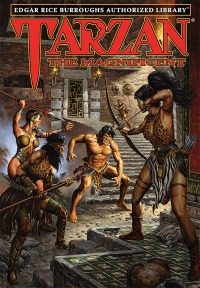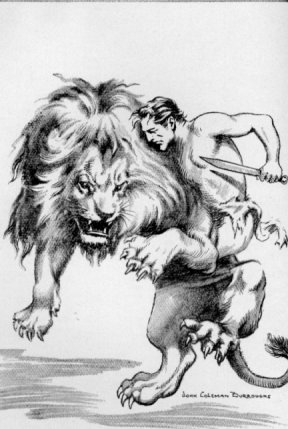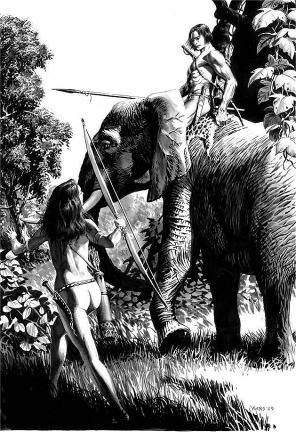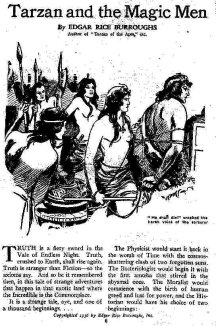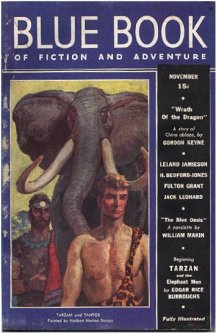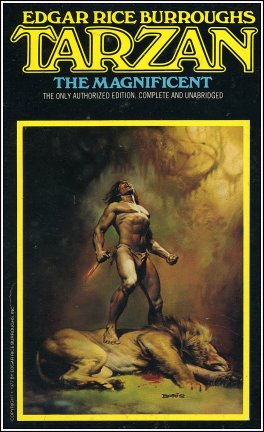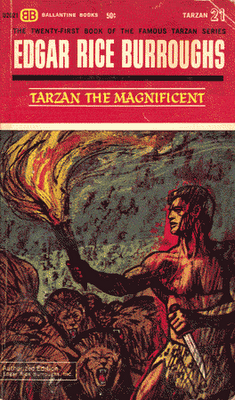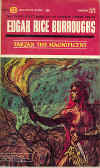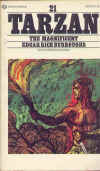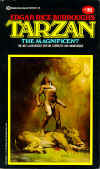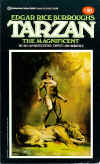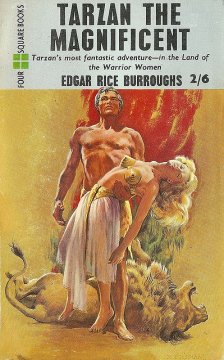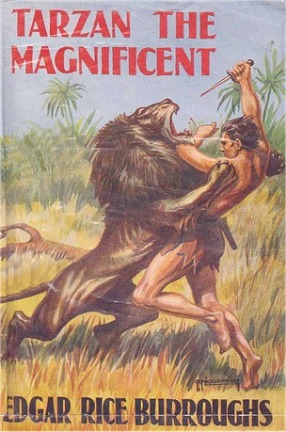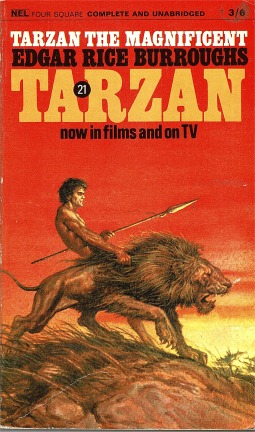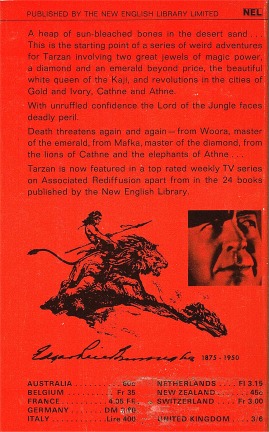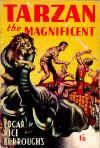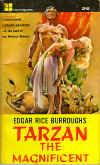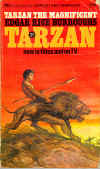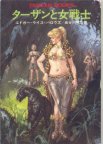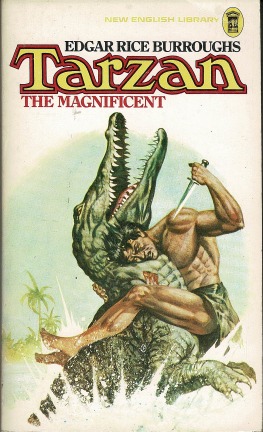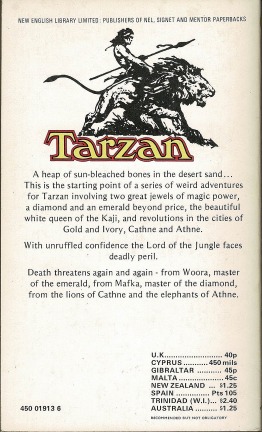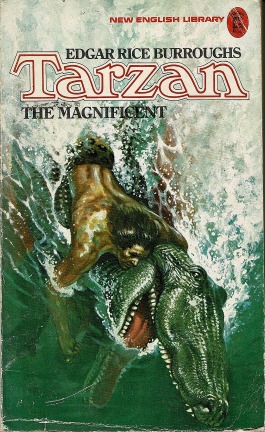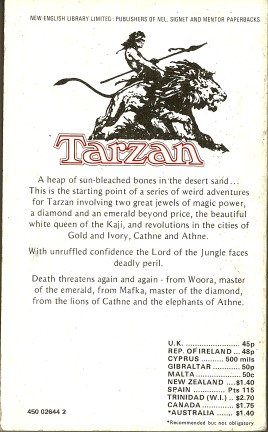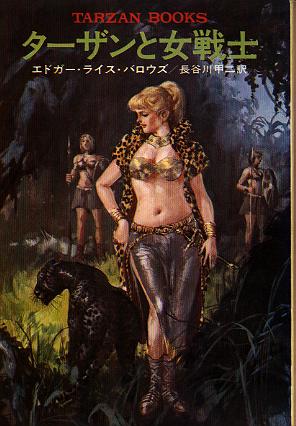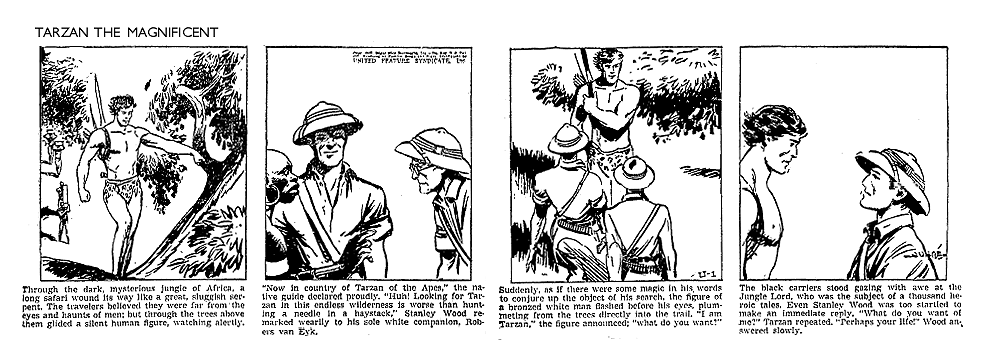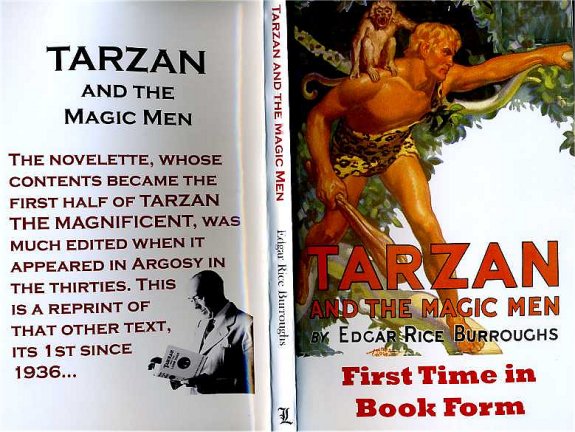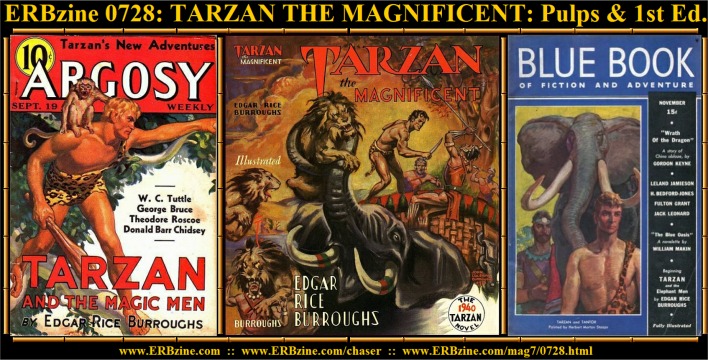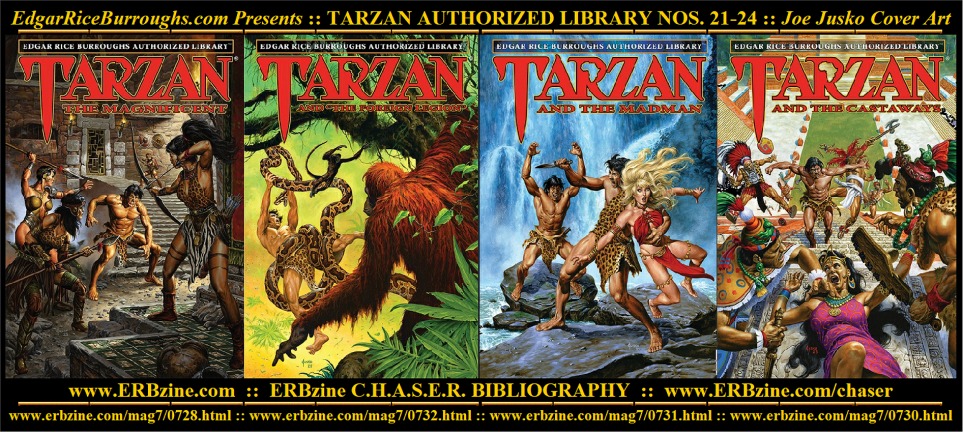TARZAN THE MAGNIFICENT
Review contributed by Doc
Hermes ERB Reviews
[This is actually two novellas which have been slightly
cut and revised to form a single book which is pretty enjoyable. After
some of the dreary entries in the second half of the series, TARZAN THE
MAGNIFICENT is a nice surprise, particularly the first half.]
"Tarzan and the Magic Men"
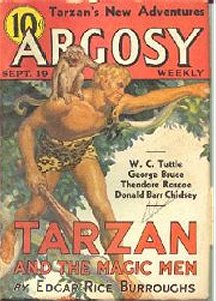 From
the September and October 1936 issues of ARGOSY (later revised to form
the first half of the book TARZAN THE MAGNIFICENT), this is a pleasant
change of pace for our Apeman, as he tackles a pair of wizened old twin
sorcerers who actually possess magic powers (well, a strong telepathic
mind control, at any rate - they don't turn people into toads or shoot
lightning bolts from their palms). The story is brisk and upbeat, with
little of those sour sermons about how vile human beings are and how idyllic
life in a jungle would be. In fact, the tone of the story is almost cheerful;
maybe Edgar Rice Burroughs was going through a good phase of his life.
From
the September and October 1936 issues of ARGOSY (later revised to form
the first half of the book TARZAN THE MAGNIFICENT), this is a pleasant
change of pace for our Apeman, as he tackles a pair of wizened old twin
sorcerers who actually possess magic powers (well, a strong telepathic
mind control, at any rate - they don't turn people into toads or shoot
lightning bolts from their palms). The story is brisk and upbeat, with
little of those sour sermons about how vile human beings are and how idyllic
life in a jungle would be. In fact, the tone of the story is almost cheerful;
maybe Edgar Rice Burroughs was going through a good phase of his life.
Tarzan himself is much more likeable and heroic here than
he was often presented in the later books. In the second half of the series,
he was shown as sometimes indifferently watching an innocent person being
stalked by a lion and not particularly caring what happens. Now, actually
there is no reason why the Apeman couldn't be characterized as an unsympathetic
anti-hero who would only help you if there was something in it for him.
Such a characterization could work and might be considered more realistic.
But frankly, I much prefer it when he's shown as genuinely noble and idealistic,
the Lord of the Jungle in truth as well as in name, who has tried to stamp
out slavery and cannibalism in the territory he has staked out for his
own.
In fact, the story opens with the Apeman prowling through
Abyssinia (now called Ethiopia), far from his usual turf, on a fact-finding
mission. ("He has come north at the behest of an emperor to investigate
a rumor that a European power is attempting to cause the defection of a
native chief by means of bribery.") In 1936, this would likely be Italian
spies working for Mussolini. Come to think of it, this means Tarzan personally
knows Haile Selassie, the genuine Ras Tafari himself... good conversation
opener if he ever goes to Jamaica!
As seems inevitable in the series, our hero finds two
colonies of white people isolated deep within Africa, carrying on a perpetual
feud. There are several aspects here that are quite different from the
usual. For one thing, the Kaji are warrior women with an unlikely cultural
program of racial manipulation. For centuries, they have been capturing
stray white men who wander past and forcing them to take as many wives
as the captured men can service (no! what a terrible fate, heh heh) with
the goal of breeding for whiteness. Don't ask me where the Kaji got this
notion, but by now (although they started as sub-Saharan African natives)
they apparently look mostly like the Swedish Bikini Team.
Now, what is interesting is that the characters wandering
into this situation (an American travel writer named Stanley Wood and his
two guides, Spike and Troll) are concerned that these stunning goddesses
at one point originally came from black African tribespeople. Wood promptly
begins a love at first sight tumble with their erratic Queen Gonfala. Never
mind that she resembles Michelle Pfeiffer in her prime, Gonfala's ancestry
would make her marriage to Wood unworkable ("I`m thinking of the Hell on
earth that would be your lot - hers and yours. You know as well as I what
one drop of colored blood does for a man or woman in the great democracy
of the U.S.A. You'd both be ostracisized by the blacks as well as the whites.
I`m not speaking from any personal prejudice; I`m just stating a fact.
It`s hard and cruel and terrible, but it still remains a fact.")
Apparently this theme upset quite a few readers back then,
but to give Stanley Wood credit, he`s in Luv and intends to take Gonfala
to the States no matter what anyone says. ("She must have Negro blood in
her - they all have; but it doesn`t seem to make any difference to me -
I'm just plain crazy about her...") As it happens, Burroughs cops out at
the end with a foreseeable plot twist that makes the romance acceptable.
There`s also a pair of great villains in this yarn, weathered
old twins named Mafka and Woora. Mafka rules the Kaji with the help of
his giant diamond talisman, the Konfal; the equally unappealing Woora leads
his split-off faction the Zuli with HIS emerald. These are genuine magic
stones with real powers of mind control and long-range hypnotism. As soon
as Tarzan snatches up the Gonfal, he feels "a strange, uncanny power that
had never before been his" and he finds he can mentally dominate everyone
around him. Jeez, it`s Sauron`s One Ring all over again! But, being the
sort of guy he is, the Apeman finds the power useful but he`s not particularly
attached to it and he arranges for one stone to be given away, while he
casually buries the other one deep in the forest in case he ever needs
it.
Tarzan himself hardly even can feel the hypnotic power
of the great jewels that others find so overwhelming. ("Like the beasts
of the jungle, he was immune [to witch-doctors and magic]. For what reason
he did not know. Perhaps it was because he was without fear; perhaps his
psychology was more that of the beast than of man.")
After Jane's much needed return in the previous book TARZAN'S
QUEST, it's good to see that she hasn`t been immediately forgotten again.
Although she doesn`t actually appear on stage, Tarzabn does takes his female
guest to stay at "his home - to the commodious bungalow where his wife
welcomed and comforted her." Notice, too, the "sprawling" building is constructed
centering around a large patio, where the guest can relax on "a reed chaise
lounge, a copy of THE ILLUSTRATED LONDON NEWS in her hand."
I like Tarzan`s duality most about the character. The
same man who drops down from a tree to kill a wild pig and then eat the
raw flesh, is the same person who taught himself Latin so he could read
the classics in their original language. The too simplistic manbeast of
some of the middle books, who was either eating or dozing in the trees
with nothing much on his mind, doesn`t appeal to me as much as this strange
complex character who is part of two different worlds.
There is one aspect of this story that is puzzling and
intriguing, and I still can`t figure out what Burroughs was trying to accomplish
with it. For the entire length of the tale, the three white men keep wondering
who this unusual guy who is helping them could be. He introduces himself
just as "Clayton" because he thinks remaining anonymous will help him gather
information (?), and although he is a nearly naked white man living in
the jungle, killing lions with a knife and screaming out the victory cry
of the great bull ape, the outsiders can`t quite figure out his identiity
until the final page when Muviro enlightens them.
What makes things puzzling is that they keep comparing
him to Tarzan ("If there were such a bird as Tarzan of the Apes, I`d say
this was he", one says, and "Say, that bird Tarzan has nothing on you.")
In fact, the Apeman seems to be teasing them with hints about his identity;
he says the names he calls the hyena and jackal are from a language not
spoken by men. For some reason, I liked this odd business. In several stories,
it`s stated that there are popular books and movies about Tarzan, and by
this point, he is so widely known by them that the general public thinks
he`s entirely fictional. When people do meet the Apeman, the idea that
he really IS Tarzan doesn`t occur to them. You can see where Philip Jose
Farmer got some of his ideas for TARZAN ALIVE.
"Tarzan and the Elephant Men"
From BLUE BOOK, where it appeared in three installments
from November 1937 through January 1938, this follow-up to "Tarzan and
the Magic Men" doesn't really match the fresh touches of telepathic mind
control and controversial miscegenation issues that made the earlier tale
interesting. Although it continues the stories of the characters Gonfala,
Stanley Wood, Spike and Troll, mostly it goes back to the familiar territory
of the opposed twin cities of Athne and Cathne which our boy visited in
TARZAN AND THE CITY OF GOLD a few books earlier. Even here, since the ferocious
Queen Nemone is slightly dead, she can't bring any of that strong sexual
tension between the Apeman and herself that gave CITY OF GOLD its strange
oppressive atmosphere. Instead, we get a lot more of the same old running
back and forth, being thrown in the dungeon and sentenced to the arena,
counterplots and scheming, checking back on the Waziri racing to the rescue...
nothing we haven't seen before, although it's presented in a solid workmanlike
way.
There are some very effective moments that just jump out
at you. This second half of wha became the book TARZAN THE MAGNIFICENT
is written with more energy and craftsmanship than some of the slack books
in the later part of the series. In one sequence, Tarzan is running for
his life from a squad of five trained Cathnean hunting lions and even the
cocky Apeman is not sure he's going to make it to the safety of the trees
when he abruptly sees a stray wild lion right in his way. By now, we have
come to accept that Tarzan can blithely knife a lion to death without getting
a scratch on him, but five thoroughbred hunting lions is a bit much, and
this situation really looks desperate. For those few pages, the story crackles
with the old vitality and tension that made the early books so great and
which started the legend.
There is also the impressive battle between the armies
of the two cities. The warriors of Athne attack riding in howdahs on the
backs of bull elephants, while the Cathnean s rely on their trained lions.
You might think, well heck, the elephants will just stomp on those cats
but instead "....a moment later, the war lions of Cathne were among them.
They did not attack the elephants, but leaped to the howdahs and mauled
the warriors. Two or three lions would attack a single elephant at a time,
and at least two of them succeeding in reaching the howdah." Quite an image!
Just imagine seeing this brought to the movies like that scene with the
Oliphants in RETURN OF THE KING. Even late in his career, Edgar Rice Burroughs
would usually pull one more trick to remind me how imaginative and powerful
a writer he could be. This battle could have benefiited from being expanded
by a few more pages; the ending does seem rushed, and some of the forgettable
Athnean stiffs could be edited out with little loss.
Burroughs is still happily slapping on coincidence in
great big slabs. Despite all those speeches about admiring animals, Tarzan
doesn't actually socialize with them except when he's trying to eat one
or one is trying to eat him. Except for elephants, with whom he has always
had a steadfast friendship. At one point, he pauses to laboriously rescue
a huge bull elephant from a pit. The mighty beast has one dark tusk and
later on in the story, the Apeman is sentenced to be trampled in the arena
by a rogue elephant the Athneans have captured. Wait a minute... you don't
think... what are the odds that this rogue will have a dark tusk?!
Although Jane doesn't appear on stage, she is mentioned
obliquely (better than nothing). Expecting to be killed in the arena, Stanley
Wood asks Tarzan if there is no message he would like to send home and
the Apeman sakes his head, "Thank you, no. She will know, as she always
has." It's also comforting to know that noble old Muviro is still on hand,
with his Waziris, still as stoic and bushido-like as ever (six of the Waziri
are ready to storm the city of Athne, even though Wood prudently points
out they couldn't possibly win. "We could try," Waranji says, "we are not
afraid."
One exchange I enjoyed is that for once someone actually
dares to contradict Tarzan's (and the author's) one-sided speeches about
how awful civilization and how wonderful living naked in the woods would
be. The Apeman refers to "the perfect peace and security of automobile
accidents, railroad wrecks, areoplane crashes, robbers, kidnapers, war
and pestilence." With a laugh, Woods replies, "But no lions, leopards,
buffaloes, wild elephants, snakes, nor tsetse flies, not to mention shiftas
and cannibals." It's about time someone spoke up in counterpoint, and Tarzan
does not blow up but just lets it pass good-naturedly.

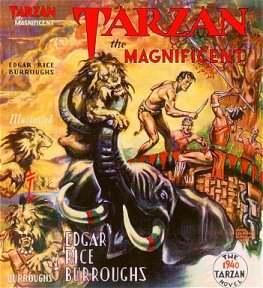 .
.